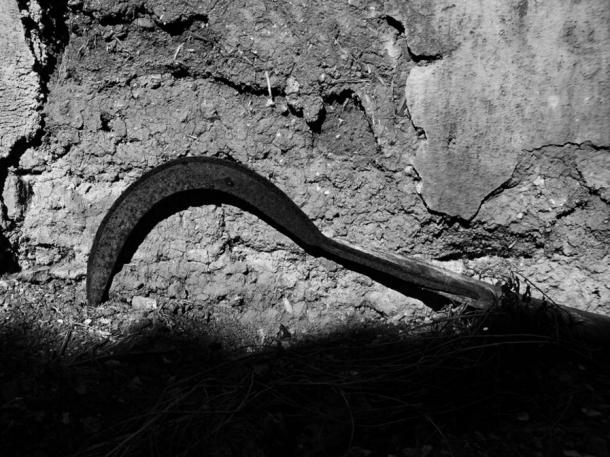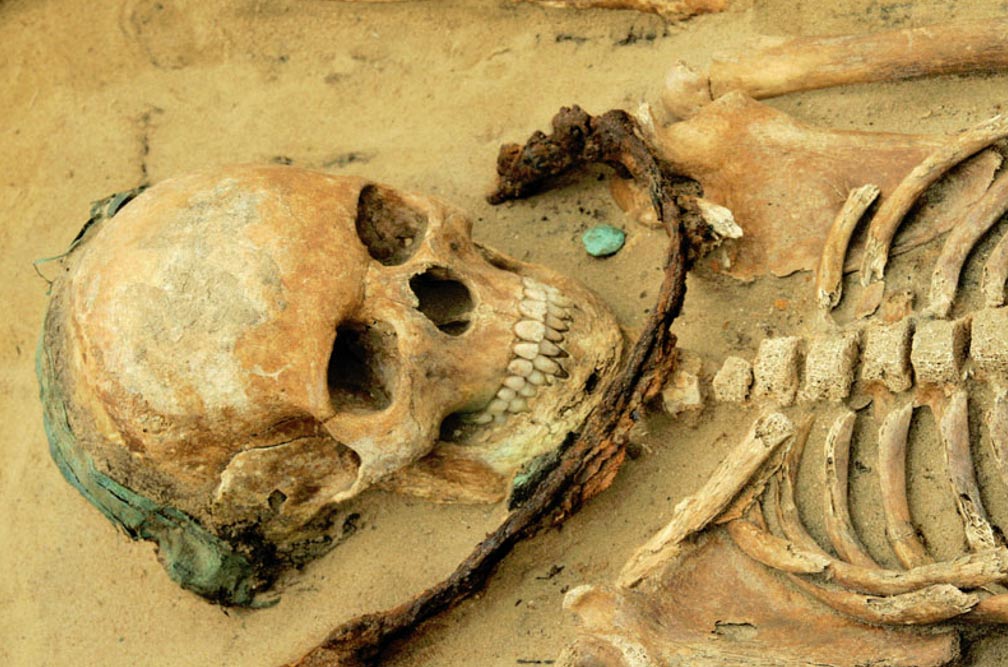17th Century Sickle Burials Reflect Belief that Demons Stalked War-Torn Poland
Poland during the 17th century was a nation torn by war, social upheaval, pestilence, famine and Catholic clerics inciting the populace with tales about the devil and witchcraft. The imaginations of many were beset by demons and vampires stalking the land.
Two researchers speculate that several bodies from that era in a graveyard in Drawsko, Poland, had sickles placed across their throats as a threat to keep them in their graves, says a new study in the journal Antiquity (abstract). The researchers note that the burials were not anti-vampiric, but rather anti-demonic and cite a number of different kinds of supernatural beings that Poles of the period believed in.
The researchers, Marek Polcyn of Lakehead University in Ontario and Elżbieta Gajda of the Ziemi Czarnkowskiej Museum in Poland, wrote:
Confining the deceased in the grave by means of a sickle may have been a measure to prevent the demonised soul threatening the living, or could have been a reference to biblical symbolism in an attempt to prevent the soul from becoming demonised. The latter approach can serve as an extension of the interpretation of the sickle as the ‘tool of God’ proposed by Wittkopp.
We deliberately dismiss the interpretation of a revenant (i.e. vampire). As noted above, there are a variety of demons into which the soul of the deceased may be transformed according to folk wisdom, with upi´or (often referred to as a vampire) being just one of those. Thus, we prefer to classify the interments from Drawsko as ‘anti-demonic’. Moreover, the sickle interments from Drawsko have none of the characteristics of so-called ‘anti-vampiric practices.’ They follow a conventional Christian burial pattern; the graves were not re-opened and the bodies of the dead were not desecrated. On the contrary, they were interred in hallowed ground, amongst the other deceased members of the community, and according to custom, which indicates that they had not been social outcasts. A similar observation is made by Borzova in relation to the mortuary sickle finds from the early Middle Ages in Slovakia.
The sickle has rich symbolism in Europe, including in the Grim Reaper and in the Bible’s final book of Revelation in which an angel announcing Judgment Day holds a sickle. The sickle is an attribute of both Ceres, the Greek goddess of agriculture, and Saturn the Roman god of the harvest. Much later, a sickle was incorporated into the Soviet Union’s flag.

A Catholic Church in Italy has the angel of death on a cardinal’s tomb. (Photo by Georges Jansoon/Wikimedia Commons)
Polcyn and Gajda wrote that people then could be considered demonic if they were strangers to the village, if they were not farmers but rather had other professions or if they looked different or abnormal. They concluded, based on traces of strontium in the teeth of these deceased people, that they were not strangers but were local. They also did not have obvious skeletal deformities that may have made their community fear them, though they could have had other, non-skeletal abnormalities.
“It seems that the dead were treated the way that they were for cultural and behavioural reasons related to who they were in life, how they lived or the circumstances of their death, rather than because of a physical disability,” they wrote.
One of the burials, a woman 50 to 60 years old, had a coin in her mouth and a stone on her neck and the sickle across her pelvis. The researchers concluded she was believed to be a witch.
A girl aged 14 to 19 with a sickle across her throat, a copper headband and a copper coin in her mouth may have died what they called a “bad death,” drowning or murder or something else, they wrote.
All three of the other bodies had the sickle across their throats and copper stains that indicated they too probably had copper coins placed in or near their mouths. One was a man, 35 to 44; another was a woman, 30 to 39; and the third was a woman, 35 to 39. The burials were otherwise normal like all the other burials in the cemetery.
Other archaeologists have noted the placing of sickles in medieval and later graves in other places in Central Europe, including in Slovakia, elsewhere in Poland, in Germany, Hungary, Lower Austria and western Romania.

Sickles are old, known even in the 13th century BC, as in this painting from Thebes in ancient Eygpt. (Wikimedia Commons)
Various researchers have interpreted the placement of sickles on the dead as grave goods for the rich or others of high status, that the deceased was a farmer or had another connection to agriculture, or as a military symbol.
“A fourth and final explanation relates sickles in graves to magic rituals and superstitions, the interpretation of which is directly derived from ethnographic data. According to Moszy´nski, all Slavs believed that hard and sharp iron objects, especially stabbing and slashing tools, had apotropaic meaning.” Apotropaic is a thing that wards away evil.
They wrote that placing the sickle across the throat of the dead in Drawkso was a threat to slit their throat if they didn’t stay in the grave. It also may have been to protect them from evil forces that would torment their souls.

The sickle has long been seen as a powerful symbol in many ancient traditions (Enrico Sanna / Flickr)
The Drawsko burials indicate that beliefs conflicting with Church burial rites resurfaced in the 17th century, the authors wrote. The wars and their attendant hunger, pestilence and poverty brought cultural and religious regression, fanaticism and a climate of terror that Catholic clergy stoked by spreading fear of witches and the devil.
“As a result, old beliefs and superstitions came back to life. A major component of the folk belief system was demonology, which influenced the spiritual life of Polish rural areas from the Middle Ages until the early twentieth century. Demonology affected life directly or indirectly at both an individual and a community level.”
The authors wrote that in popular belief there were five types of demons: three mythical types and two human types. The human types included demons that were believed to be incarnations of dead people, and living people who were thought to have supernatural powers.
Featured image: A girl age 14 to 19 was buried with a sickle across her throat, a copper headband and a coin near her mouth; the authors of a new study said her community may have thought she had demonic tendencies. (Antiquity photo)
By: Mark Miller




















Comments
There is a fencing book from Paulus Hector Mair, 16th century, that describes how to effectively fight with Sickles. Go there http://wiktenauer.com/wiki/Paulus_Hector_Mair scroll down and click on Sickle. You'll find there flail, scythe and "paesant staff" as well. I think humans always used whatever they could as weapon. Take modern martial arts, they teach you how to use a key or pen or anything else as a weapon.
Sickles probably just the only weapons Civilisations not into warfare had back then? The corps above with the sickle is a member af an asian/japanese warfaring plunder civilisation plundering and raping Europe for many centuries now!
Pretty darn good teeth for NOT HAVING FLUORIDE! However did we survive?